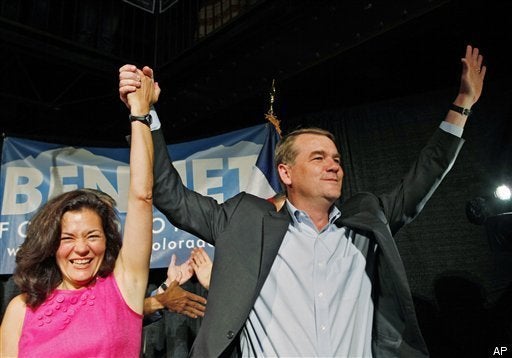
With less than three months to go, I thought it'd be a good time to take a quick look at how the midterm elections are shaping up in the Senate. For now, we'll ignore the House races (because, truth be told, there are just too many of them to keep track of in such a microscopic fashion). While there are still a few remaining primary races to lock in who will be the nominee, in most states the slate is set for the Senate at this point. Which means we can finally take a close look at the situation.
I should say, up front, that I think Democrats are going to lose a few seats in the Senate, but that they will retain control of the chamber after the votes are counted. But while the House remains volatile in this respect, the landscape for the Senate has noticeably improved for the Democrats. So there's a little good news and a little bad news for everyone.
There are 37 Senate seats up for grabs this year. Democrats start off with a built-in advantage over the Republicans, since of the 63 seats not up for election this year, 40 are in Democratic hands, to the Republicans' 23. But this is about the only advantage Democrats have this year, and it becomes quickly eroded when you look at the landscape of the 2010 races. To break them down, we'll shuffle them all into five categories -- Safe Republican, Safe Democratic, Lean Republican, Lean Democratic, and Too Close To Call. We're going to start off pigeonholing these fairly skeptically, so that as the election gets closer we can see how things firm up.
Safe Republican
[AL, AK, AZ, GA, ID, KS, ND, OK, SC, SD, UT]
These are the races that are already "in the bag" for Republicans, and there are quite a few of them. The Mountain West states (Arizona, Idaho, Utah, and Alaska) are all Republican strongholds, as are all the Great Plains states (Kansas, Oklahoma, and both Dakotas). North Dakota will be a pickup seat for the Republicans, due to the retirement of Democrat Byron Dorgan. Add to this three Deep South states (Alabama, Georgia, and South Carolina), and Republicans wind up with 34 safe seats (adding this group to the senators not up for re-election) this year.
Safe Democratic
[HI, MD, NY(a), VT]
Democrats, however, only really have four races in the bag this year -- Hawai'i, Maryland, Vermont, and one of the races in New York (both New York seats are up for grabs this time around), where Senator Chuck Schumer is going to coast to re-election. Adding these safe seats to those not up for election this year gives us a total of 44 seats.
Lean Republican
[DE, IA, IN, MO, NC, NH]
In Delaware, Joe Biden's old seat is likely going to fall to the Republicans, due to Biden's son deciding not to seek his father's Senate seat. Iowa's Charles Grassley also looks pretty solid. So does Indiana, for that matter. In Missouri, as of this writing it looks good for the Republicans, but this is a fairly volatile race, and things could change in the future. Missouri is an open seat, which was previously held by a Republican. North Carolina is another seat that could turn volatile, but at this point looks like it'll go Republican. In New Hampshire, Judd Gregg's retirement has left another open race, but at this point it seems to be going Republican as well.
Republican lean states plus Republican safe seats equals 40, at this point. Delaware and Indiana are the second and third pickup states for Republicans, putting them up three seats over Democrats overall.
Lean Democratic
[CT, NY(b), OR, WV]
Connecticut's race will be catnip to political reporters this year because the Republicans have nominated quite a colorful character. I'm not sure any other senatorial candidate in this election cycle has a video of them kicking a man in the crotch, for instance. But the Democrat in the race is well-known and well-loved by the voters, and even with his stumble (on military service claims), he will likely coast to victory in November. In New York state, appointed Senator Gillibrand will almost certainly defeat her Republican nominee (this race will likely move to Safe Democratic soon). Likewise in Oregon, where the Democrat's polling numbers are pretty solid. West Virginia is having a special election to fill Robert Byrd's seat and will also likely go to a very popular state Democratic politician.
If Democrats pick up all their leans, together with their safe seats, they will hold onto 48 seats, giving them a big advantage in retaining control of the chamber.
Too Close To Call
[AR, CA, CO, FL, IL, LA, KY, NV, OH, PA, WA, WI]
This leaves twelve races in the tossup category. Again, I'm being fairly conservative about which races to include here, and some of these will likely firm up one way or another before the actual election. Since there are so many of them, a quick overview of each is all we've got time for.
Arkansas had a hard-fought primary among Democrats, but at this point it looks like the nomination was fought over who gets the chance to lose to a Republican.
California has had Republicans salivating over the prospect of defeating Barbara Boxer, but my guess is that this isn't going to happen. California's electorate may decide on a Republican governor this time around, but I think they'll also send Boxer back to Washington.
Colorado's primary just happened, so it'll likely take a few weeks for polling numbers to settle down into showing the electorate's mood, now that everyone knows who will be on the ballot. At this point, the Tea Party/Republican candidate is up a bit, but not all that much, so we'll have to see how this settles out. For now, I'll put it in the Republican column.
In Florida, there's a three-way race going on, which former governor (and former Republican) Charlie Crist may just win. If he does, the expectation is that he will decide to caucus with the Democratic Party in the Senate, meaning that this race could be one of the few bright spots for Democrats, since if this does happen it will effectively be a pickup for the Democrats.
Illinois is another tight one, but for the moment the Democrat is slightly up in the polls, so we'll chalk it up in the Democrats' column, for now. Since it is a very close race, this could change at any time, however.
If Louisiana's David Vitter survives a primary challenge, he will likely hang onto his seat (even after he weathered a prostitute scandal). But his primary challenger could steal it away from him, so we're leaving this in the tossup category for now, although the seat is likely to stay Republican either way.
Kentucky's Rand Paul has been leading in the polls pretty consistently, but (due to being Rand Paul) he could always say something wacky that causes this to turn around. For now, we'll put this in the Republican column, though.
Nevada will most likely be the closest-watched race this year because Senate Majority Leader Harry Reid may be in trouble. Helping his chances out, however, is the candidate he's now running against, who is just about the Tea-Partiest Tea Party candidate running this year. In other words, you can all but count on her saying something wacky. Reid's chances have noticeably improved since the primary, and we're going to say that Harry squeaks it out on election day.
Ohio is going to be a very close race, if the polling is any indication. The lead has gone back and forth a number of times already, and could switch several more times before the actual election. For now, it appears the Republican is up, so we'll put it in the Republican column, but chances are this will change.
Pennsylvania is another close race, and Joe Sestak may pull it out in the end. However, the Republican seems to have a decent lead, so we'll call it Republican for now.
Washington state will likely stay in the Democratic column, but polling has been fairly close, so it's not a guarantee.
Wisconsin's Russ Feingold is in a very tight race, but at this point it looks like he'll hold onto his seat in November.
Conclusion
Of the tossup states, Democrats look (at this point) like they'll take six of them (CA, FL, IL, NV, WA, WI), and Republicans will take six (AR, CO, LA, KY, OH, PA).
This means Democrats will pick up one previously Republican-held seat (FL), while Republicans pick up six seats (ND, IN, DE, AR, CO, PA) from the Democrats. This adds up to a net five-seat pickup for the Republicans, and puts the next Senate at 46 Republicans, 54 Democrats (51 plus three independents, really). This will make it harder for Democrats to get anything done in the chamber, obviously, but is also a far cry from Republicans taking over the majority.
Of course, the election isn't being held today, meaning that all of this could change as we get closer to November, so stay tuned as we'll be revisiting these numbers occasionally before election day dawns.
Chris Weigant blogs at:
Follow Chris on Twitter: @ChrisWeigant
